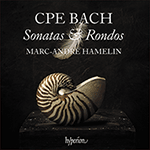In contrast to the fiery tones of the first sonata, the Sonata in A flat major reveals C P E Bach’s gift for imitating the nuances of the human voice through the medium of the harpsichord. A rising opening melody is followed by a quick second theme whose intensity acts as a contrast to the virtual trio of singers heard at the beginning. Bach’s uniquely wayward musical personality is evident at certain points, such as the ending of the first half of the first movement when the music moves into a minor tonality and the emotionally charged cantabile is given dramatic impetus by the use of dissonance. Contrasts of mood are further explored in the second movement, a touching piece where the flittering between unrelated motifs almost ‘decomposes’ into quasi-recitative. Bach’s literary influences are apparent here, as he blurs the line between prosody and poetry. A sense of declamation is again evident in the final Allegro. Here the master of the intense and dramatic shows us that he has an equally developed sense of humour. What this lively dance for the fingers lacks in ‘Bachian’ counterpoint it gains in a very different kind of interplay—namely, that of timbres and Affekts.
from notes by Mahan Esfahani © 2014
Par contraste avec l’ardeur de cette première sonate, la Sonate en la bémol majeur révèle combien C. P. E. Bach était doué pour imiter les nuances de la voix humaine via le registre médium du clavecin. À une mélodie ascendante succède un second thème rapide, dont l’intensité tranche avec le trio de chanteurs virtuel du début. La personnalité musicale remarquablement imprévisible de Bach est, à certains moments, flagrante, comme à la fin de la première moitié du premier mouvement, quand la musique passe au mineur et que le cantabile chargé d’émotion se voit insuffler un élan dramatique par le recours à la dissonance. Les contrastes de climat sont explorés plus avant dans le deuxième mouvement, morceau touchant où le volettement entre des motifs non connexes se «décompose» presque en quasi-récitatif. Voilà un Bach aux influences littéraires évidentes, qui brouille la frontière entre prosodie et poésie. Le sentiment de déclamation se fait de nouveau patent dans l’Allegro final. Ici, le maître de l’intense et du tragique nous montre qu’il a un sens de l’humour tout aussi développé. Tout ce que cette entraînante danse pour les doigts n’a pas en contrepoint «bachien», elle le gagne dans un tout autre type de jeu—entre les timbres, les Affekts.
extrait des notes rédigées par Mahan Esfahani © 2014
Français: Hypérion
Im Gegensatz zu den feurigen Tönen der ersten Sonate offenbart die Sonate in As-Dur Emanuel Bachs Gabe, die Nuancen der menschlichen Stimme am Cembalo zu imitieren. Auf eine aufsteigende Anfangsmelodie folgt ein rasches zweites Thema, dessen Intensität als Gegengewicht zu dem „Sängerterzett“ vom Beginn eingesetzt wird. Bachs einzigartige und eigenwillige musikalische Persönlichkeit kommt an gewissen Stellen zum Ausdruck, so etwa am Ende der ersten Hälfte des ersten Satzes, wo die Musik nach Moll wechselt und das emotional aufgeladene Kantabile durch den Einsatz von Dissonanzen dramatische Triebkraft erhält. Auch im zweiten Satz finden Stimmungswechsel statt—es handelt sich dabei um ein anrührendes Stück, wo das Umherspringen zwischen unzusammenhängenden Motiven fast in ein „Quasi-Rezitativ“ zerfällt. Wenn er die Grenze zwischen Prosodie und Lyrik verschwimmen lässt, werden Bachs literarische Einflüsse offensichtlich. Im letzten Satz, Allegro, kommt wiederum eine gewisse Deklamatorik zum Vorschein. Hier zeigt der Meister des intensiven und dramatischen Stils, dass er einen ebenso ausgeprägten Sinn für Humor besitzt. Was diesem lebhaften Fingertanz an „Bachischem“ Kontrapunkt fehlt, wird durch eine völlig andere Art des Zusammenspiels wettgemacht—nämlich das der Timbres und Affekte.
aus dem Begleittext von Mahan Esfahani © 2014
Deutsch: Viola Scheffel



 PERFORMANCE
PERFORMANCE RECORDING
RECORDING PERFORMANCE
PERFORMANCE PERFORMANCE
PERFORMANCE Bach (CPE): Sonatas & Rondos
Bach (CPE): Sonatas & Rondos
